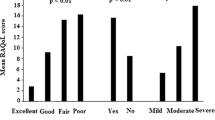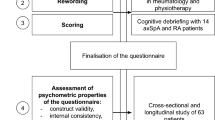Abstract
Disability has been identified as a core outcome measure in rheumatoid arthritis (RA). The aim of this study was to perform a comprehensive psychometric analysis of the Recent-Onset Arthritis Disability (ROAD) questionnaire in patients with RA. The questionnaire was completed by 583 patients with RA: 196 subjects participating in the NEW INDICES study and 387 subjects who were taking part in a long-term observational study. At confirmatory factor analysis for categorical data, data fit for a three-factor model was adequate to good (non-normed fit index = 0.98, comparative fit index = 0.99, root mean square error of approximation = 0.079, standardized root mean square residual = 0.047), with standardized item-to-factor loadings ranging from 0.60 to 0.90 and a cumulative explained variance of 83 %. The bifactor model of ROAD presented a clean independent cluster structure. The loadings in the unidimensional model were very similar to those on the general factor in the bifactor model. Rasch analysis showed a correct functioning of rating categories, a good fit of the data to the model for all three subscales, and satisfactory separation indexes and respective reliability (for both persons and items). This study, using both classical test theory and Rasch analysis methods, provides psychometric evidence of the reliability and internal and structural validity of ROAD in RA patients. Our results support the use of separate subscores for upper limb function, lower limb function, and activities of daily living/work, and the appropriateness of reporting an overall score (i.e., the mean of the three subscales).
Similar content being viewed by others
References
Verstappen SM, Symmons DP (2011) What is the outcome of RA in 2011 and can we predict it? Best Pract Res Clin Rheumatol 25(4):485–96
Salaffi F, De Angelis R, Stancati A, Grassi W, MArche Pain; Prevalence INvestigation Group (MAPPING) study (2005) Health-related quality of life in multiple musculoskeletal conditions: a cross-sectional population based epidemiological study. II. The MAPPING study. Clin Exp Rheumatol 23(6):829–39
Kalyoncu U, Dougados M, Daurès JP, Gossec L (2009) Reporting of patient-reported outcomes in recent trials in rheumatoid arthritis: a systematic literature review. Ann Rheum Dis 68(2):183–90
Fries JF, Spitz P, Kraines RG, Holman HR (1980) Measurement of patient outcome in arthritis. Arthritis Rheum 23(2):137–45
Meenan RF, Mason JH, Anderson JJ, Guccione AA, Kazis LE (1992) AIMS2. The content and properties of a revised and expanded Arthritis Impact Measurement Scales health status questionnaire. Arthritis Rheum 35:1–10
Ware JE Jr, Sherbourne CD (1992) The MOS 36-item short form health survey (SF-36). 1. Conceptual frame-work and item selection. Med Care 30:473–81
Oude Voshaar MA, ten Klooster PM, Taal E, van de Laar MA (2011) Measurement properties of physical function scales validated for use in patients with rheumatoid arthritis: a systematic review of the literature. Health Qual Life Outcomes 9:99
Pincus T, Yazici Y, Bergman M (2005) Development of a multi-dimensional health assessment questionnaire (MDHAQ) for the infrastructure of standard clinical care. Clin Exp Rheumatol 23:S19–28
Salaffi F, Gasparini S, Grassi W (2009) The use of computer touch-screen technology for the collection of patient-reported outcome data in rheumatoid arthritis: comparison with standardized paper questionnaires. Clin Exp Rheumatol 27:459–68
Salaffi F, Bazzichi L, Stancati A, Neri R, Cazzato M, Consensi A, Grassi W, Bombardieri S (2005) Development of a functional disability measurement tool to assess early arthritis: the Recent-Onset Arthritis Disability (ROAD) questionnaire. Clin Exp Rheumatol 23(5):628–36
Salaffi F, Stancati A, Neri R, Grassi W, Bombardieri S (2005) Measuring functional disability in early rheumatoid arthritis: the validity, reliability and responsiveness of the Recent-Onset Arthritis Disability (ROAD) index. Clin Exp Rheumatol 23:S31–42
Conrad KJ, Smith EV Jr (2004) International conference on objective measurement: applications of Rasch analysis in health care. Medical Care 42(Suppl 1):I1–6
Bond TG, Fox CM (2007) Applying the Rasch model: fundamental measurement in the human sciences, 2nd edn. Lawrence Erlbaum Associates, Mahwah
Salaffi F, Migliore A, Scarpellini M, Corsaro SM, Laganà B, Mozzani F, Varcasia G, Pusceddu M, Pomponio G, Romeo N, Maier A, Foti R, Scarpa R, Gasparini S, Bombardieri S (2010) Psychometric properties of an index of three patient reported outcome (PRO) measures, termed the CLinical ARthritis Activity (PRO-CLARA) in patients with rheumatoid arthritis. The NEW INDICES study. Clin Exp Rheumatol 28(2):186–200
Salaffi F, Ciapetti A, Gasparini S, Migliore A, Scarpellini M, Corsaro SM, Laganà B, Mozzani F, Varcasia G, Pusceddu M, Castriotta M, Serale F, Maier A, Foti R, Scarpa R, Bombardieri S, NEW INDICES Study Group (2010) Comparison of the Recent-Onset Arthritis Disability questionnaire with the Health Assessment Questionnaire disability index in patients with rheumatoid arthritis. Clin Exp Rheumatol 28(6):855–65
Streiner DL, Norman GR (2005) Health measurement scales: a practical guide to their development and use, 2nd edn. Oxford University Press, Oxford
Jöreskog KG (1990) New developments in LISREL: analysis of ordinal variables using polychoric correlations and weighted least squares. Qual Quant 24:387–404
Hu L, Bentler PM (1999) Cutoff criteria for fit indexes in covariance structure analysis: conventional criteria versus new alternatives. Struct Equat Model 6:1–55
Reise SP, Morizot J, Hays RD (2007) The role of the bifactor model in resolving dimensionality issues in health outcomes measures. Qual Life Res 16(S1):19–31
Lorenzo-Seva U, Ferrando PJ (2006) FACTOR: a computer program to fit the exploratory factor analysis model. Behav Res Methods Instrum Comput 38(1):88–91
Linacre JM (2009) A user’s guide to WINSTEPS MINISTEP: Rasch-model computer programs. Program manual 3.68.0. Chicago: WINSTEPS.com; 2009. http://www.winsteps.com/a/winsteps.pdf. Accessed 29 July 2010
Linacre JM (2002) Optimizing rating scale category effectiveness. J Appl Meas 3:85–106
Smith AB, Rush R, Fallowfield LJ, Velikova G, Sharpe M (2008) Rasch fit statistics and sample size considerations for polytomous data. BMC Med Res Methodol 8:33
Frost MH, Reeve BB, Liepa AM, Stauffer JW, Hays RD, Mayo/FDA Patient-Reported Outcomes Consensus Meeting Group (2007) What is sufficient evidence for the reliability and validity of patient-reported outcome measures? Value Health 10(Suppl 2):S94–105
Reeve BB, Hays RD, Bjorner JB et al (2007) Psychometric evaluation and calibration of health-related quality of life item banks: plans for the Patient-Reported Outcomes Measurement Information System (PROMIS). Med Care 45(Suppl 1):S22–31
Coste J, Bouée S, Ecosse E, Leplège A, Pouchot J (2005) Methodological issues in determining the dimensionality of composite health measures using principal component analysis: case illustration and suggestions for practice. Qual Life Res 14:641–54
ten Klooster PM, Veehof MM, Taal E, van Riel PL, van de Laar MA (2008) Confirmatory factor analysis of the Arthritis Impact Measurement Scales 2 short form in patients with rheumatoid arthritis. Arthritis Rheum 59(5):692–8
Guillemin F, Coste J, Pouchot J, Ghezail M, Bregeon C, Sany J, The French Quality of Life in Rheumatology Group (1997) The AIMS2-SF: a short form of the Arthritis Impact Measurement Scales 2. Arthritis Rheum 40:1267–74
Ren XS, Kazis L, Meenan RF (1999) Short-Form Arthritis Impact Measurement Scales 2: tests of reliability and validity among patients with osteoarthritis. Arthritis Care Res 12:163–71
Acknowledgments
We thank Giardino A., Ori A., Zanoli L., and Manfredi A. for their contribution to the organization of the study and data management. The authors also wish to thank the other members of the NEW INDICES Study Group, as follows: Laganà B. (Roma), Varcasia G. (Mormanno, Cosenza), Pomponio G. (Ancona), Mozzani F. (Parma), Scarpa R. (Napoli), Maier A. (Bolzano), Romeo N. (Cuneo), Migliore A. (Roma), Scarpellini M. (Magenta, Milano), Corsaro S.M. (Napoli), Pusceddu M. (Iglesias, Cagliari), Foti R. (Catania), Rotondi M. (Velletri, Roma), Marasini B. (Rozzano, Milano), Ferraccioli G. (Roma), Malavolta N. (Bologna), Sabadini L. (Arezzo), Cimmino M. (Genova), Ricioppo A. (Vimercate, Milano), Triolo G. (Palermo), Mascia M.T. (Modena), Minisola G. (Roma), Botsios K. (Montebelluna, Treviso), Pellerito R. (Torino), Noto A. (Cosenza), Cazzato M. (Pisa), Bombardieri S. (Pisa). Part of the study (data collection) was supported by an unrestricted educational grant from Pfizer S.p.A., Italy. Editorial support was provided by Kim Brown of UBC Scientific Solutions and was funded by Pfizer Inc.
Disclosures
FS has attended advisory board meetings for Bristol-Myers Squibb, Abbott Immunology, Wyeth Lederle, and Pfizer, and has received research support from Bristol-Myers Squibb. The remaining authors have no financial or other competing interests to declare.
Author information
Authors and Affiliations
Consortia
Corresponding author
Rights and permissions
About this article
Cite this article
Salaffi, F., Franchignoni, F., Giordano, A. et al. Classical test theory and Rasch analysis validation of the Recent-Onset Arthritis Disability questionnaire in rheumatoid arthritis patients. Clin Rheumatol 32, 211–217 (2013). https://doi.org/10.1007/s10067-012-2101-6
Received:
Revised:
Accepted:
Published:
Issue Date:
DOI: https://doi.org/10.1007/s10067-012-2101-6




